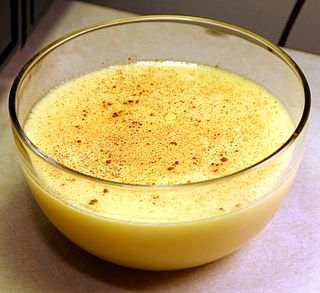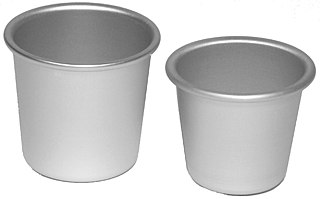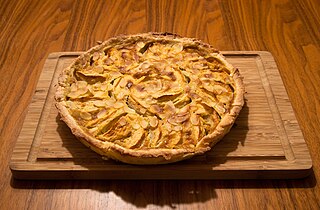
The pantxineta is a typical dessert of the Basque Country. It consists of a bun of puff-pastry filled with thick custard cream; it is topped with almonds and often decorated with icing sugar.

The pantxineta is a typical dessert of the Basque Country. It consists of a bun of puff-pastry filled with thick custard cream; it is topped with almonds and often decorated with icing sugar.
The Dictionary of Basque gastronomy defines the "pantxineta" as a tart of puff-pastry and custard cream created at the beginning of the 20th century in San Sebastián by the House of Otaegui, a local patisserie, ca. 1915. Back then, San Sebastian was a summer vacation resort for the Spanish royalty, aristocrats and bourgeoisie; patisseries and restaurants thrived, usually serving food and dishes heavily influenced by the cuisine of nearby France. Apparently, the pantxineta was devised in an attempt to imitate traditional French frangipane tarts; however, instead of employing the usual almond-based frangipane filling, a baker at Otaegui used a thick custard, and covered the tart with an outer layer of puff-pastry. They initially called the desert a "frantxi-pan", which in the local basque dialect quickly evolved into "pantxineta".
Since its inception, the desert has grown in popularity due to its simplicity and tastiness, and it is nowadays considered one of the cornerstone desserts of Basque cuisine. It is usually served warm, either reheated or, whenever possible, straight out of the baking oven. Sometimes it is served along hot chocolate syrup, which is poured on top of the pastry.
The principal ingredients of the pantxineta are milk, butter, sugar, eggs, flour, almonds and hazelnuts.

Custard is a variety of culinary preparations based on sweetened milk, cheese, or cream cooked with egg or egg yolk to thicken it, and sometimes also flour, corn starch, or gelatin. Depending on the recipe, custard may vary in consistency from a thin pouring sauce to the thick pastry cream used to fill éclairs. The most common custards are used in custard desserts or dessert sauces and typically include sugar and vanilla; however, savory custards are also found, e.g., in quiche.

Pastry refers to a variety of doughs, as well as the sweet and savoury baked goods made from them. These goods are often called pastries as a synecdoche, and the dough may be accordingly called pastry dough for clarity. Sweetened pastries are often described as bakers' confectionery. Common pastry dishes include pies, tarts, quiches, croissants, and pasties.

Zeppole, in Sardinia italianized zippole or zeppole sarde from the original Sardinian tzípulas, is an Italian pastry consisting of a deep-fried dough ball of varying size but typically about 4 inches (10 cm) in diameter. This fritter is usually topped with powdered sugar, and may be filled with custard, jelly, cannoli-style pastry cream or a butter-and-honey mixture. The consistency ranges from light and puffy, to bread- or pasta-like. It is eaten to celebrate Saint Joseph's Day, which is a Catholic feast day.

A mille-feuille, also known by the names Napoleon in North America, vanilla slice in the United Kingdom, and custard slice, is a French dessert made of puff pastry layered with pastry cream. Its modern form was influenced by improvements made by Marie-Antoine Carême.

Dariole is a French term for a small culinary mold in the shape of a truncated cone. The word also refers to the dessert that is baked in the mold. Classically, the dessert is an egg-custard filled puff pastry. In the Middle Ages they sometimes included fruit, cheese, bone marrow or fish inside the pastry.

Frangipane is a sweet almond-flavored custard, typical in French pastry, used in a variety of ways, including cakes and such pastries as the Bakewell tart, conversation tart, Jésuite and pithivier. A French spelling from a 1674 cookbook is franchipane, with the earliest modern spelling coming from a 1732 confectioners' dictionary. Originally designated as a custard tart flavored by almonds or pistachios, it came later to designate a filling that could be used in a variety of confections and baked goods.

A cremeschnitte, also known as vanilla slice or custard slice, is a custard and chantilly cream cream cake dessert commonly associated with the former Austro-Hungarian Monarchy. However, its exact origin is unknown. This dish remains popular across Central Europe and the Balkans in various variations, all of which include a puff pastry base and custard cream.

Custard tarts or flan pâtissier/parisien are a baked pastry consisting of an outer pastry crust filled with egg custard.

A lemon tart is a dessert dish, a variety of tart. It has a pastry shell with a lemon flavored filling.

Normandy tart is a shortcrust pastry-based variant of the apple tart made in Normandy filled with apples, sliced almonds and sugar, topped with creamy egg custard and baked until the topping is slightly caramelised. It is also known in French as la Tarte Normande.

A Jésuite is a triangular, flaky pastry filled with frangipane cream and topped with sliced almonds and powdered sugar. The pastry originated in France and the name refers to the triangular shape of a Jesuit's hat.

Sponge cake is a light cake made with eggs, flour and sugar, sometimes leavened with baking powder. Some sponge cakes do not contain egg yolks, like angel food cake, but most of them do. Sponge cakes, leavened with beaten eggs, originated during the Renaissance, possibly in Spain. The sponge cake is thought to be one of the first non-yeasted cakes, and the earliest attested sponge cake recipe in English is found in a book by the English poet Gervase Markham, The English Huswife, Containing the Inward and Outward Virtues Which Ought to Be in a Complete Woman (1615). Still, the cake was much more like a cracker: thin and crispy. Sponge cakes became the cake recognised today when bakers started using beaten eggs as a rising agent in the mid-18th century. The Victorian creation of baking powder by English food manufacturer Alfred Bird in 1843 allowed the addition of butter to the traditional sponge recipe, resulting in the creation of the Victoria sponge. Cakes are available in many flavours and have many recipes as well. Sponge cakes have become snack cakes via the Twinkie.

Gâteau Basque is a traditional dessert from the Northern Basque region of France, typically filled with black cherry jam or pastry cream. Gâteau Basque with cream is more typical in the Southern Basque region of Spain.